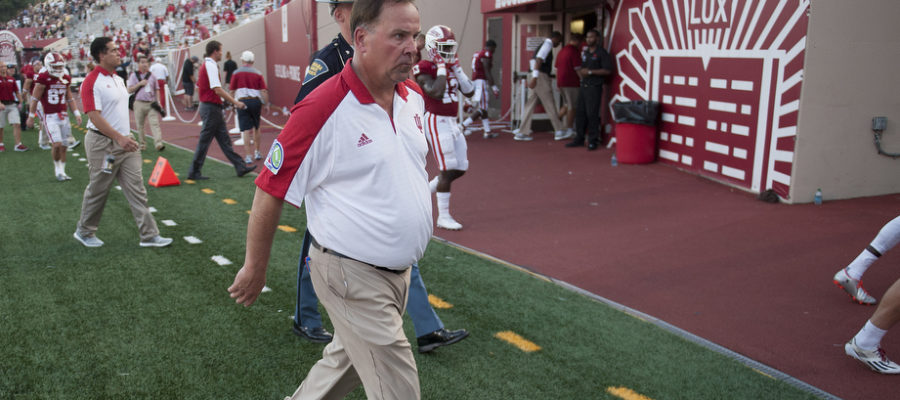
Article reposted from Hoosier Sports Report
Author: Mike Miller
An upcoming episode of ESPN’s “Outside The Lines” will explore alleged medical mistreatment of Indiana University athletes.
It’s a widely-circulated topic following the departure of former football coach Kevin Wilson, but ESPN’s program is not focusing solely on the Hoosier football program. Rather, it will also inspect concerns with the women’s rowing program and IU’s handling and reporting of injuries as an athletic department.
The episode will air Sunday at 9 a.m. on ESPN, with rebroadcasts at 10 a.m. on ESPN2 and 11 a.m. on ESPNews.
“We started taking a look at Indiana athletics after the departure of Kevin Wilson and the injured football players who came out and said they felt they were mistreated, and Coach Wilson’s demeanor and behavior had a lot to do with that,” ESPN investigative reporter Paula Lavigne said. “We talked to a few of the players. It was interesting, because there were players who criticized Wilson and his demeanor, and almost all the players were in agreement that, as one player put it, he’s a very hard coach. He’s very animated. I think everybody we talked to was in agreement that he has a very in-your-face style. What they were in disagreement on was whether or not his behavior toward the athletic training staff to the players is what caused them problems. The story takes a closer look at the medical staff and the medical care of student-athletes at Indiana.”
Wilson resigned as coach on Dec. 1 due to what Indiana athletic director Fred Glass deemed “philosophical differences.” In the wake of his resignation, former Hoosier defensive lineman Nick Carovillano alleged that IU’s training staff mishandled a back injury suffered in 2014. Former receiver Dominique Booth has also alleged that concussions suffered while playing at IU were not handled with care.
Carovillano told The Herald-Times in December that he believed IU trainers operated under strong pressure from Wilson, who Carovillano says would berate staffers if he felt they were coddling players.
Wilson, now the offensive coordinator at Ohio State, has since told reporters that there is no truth to the allegations.
Glass did issue a formal reprimand to Wilson in 2015 after an external investigation into IU’s treatment of injured players determined that there were noticeable behaviors by IU football coaches that contributed to an unsatisfactory environment for players.
The results of a second investigation into IU’s football program, conducted this past season, have not been released by the university.
“We were assigned to work on this story that was sparked by Kevin Wilson leaving,” OTL producer Willie Weinbaum said. “We worked on telling that story. In the course of the reporting, Paula uncovered a complaint that had been levied against the medical director for IU athletics, Andy Hipskind. That led to telling another story, in essence. A story about an athlete in another sport. Not a football player, not a male student-athlete, but a female student-athlete and a rower.”
Lavigne and Weinbaum said they interviewed a few people associated with IU’s rowing program off camera. On camera, they focused on former rower Katlin Beck.
“What we do is tell two stories that have a strong connection,” Weinbaum said. “One story involves the football program and the athletic training staff and the doctors. Another story involves the rowing team and the student-atheltes and the athletic training staff and the doctors. There’s a lot of overlap, but if we had just looked at everything related to football as opposed to taking the broader view, we never would have known about the other story.”
Indiana officials declined to comment to The Herald-Times on Friday ahead of the episode’s premiere.
In reporting the story, Lavigne said Glass declined to comment, as did IU’s athletic trainers and team physicians. IU officials did agree to answer some questions via email, Lavigne said.
“A couple of the things we would’ve liked more information about were the investigations they did,” Lavigne said. “I know this was an issue for everyone around the time of Wilson’s departure. So you did these investigations, what type of questions were you asking? What were the answers? We got a summary and bullet points and things, but it would’ve been nice to have received a little more context, and also to find out a little bit more about the investigation that happened in the fall that they referenced. We filed open records requests for all of those. That was denied. Unfortunately, they’re not being fully transparent about that.”
Lavigne and Weinbaum said the episode is structured in a way that will allow viewers to make their own decisions.
“In the interest of fairness, it’s worth pointing out that Indiana officials say they’ve made a number of changes already,” Lavigne said. “Obviously, they have a new football coach (Tom Allen) in the picture. They have committed to training the athletic trainers and the medical staff and the coaches as to the reporting structure for injuries, re-emphasizing who makes decisions and then making some changes internally to improve the accountability of the head team physicians to the university and they have a new contract with their healthcare provider. They have made some changes, so it’ll be interesting to see the responses from the student-athletes moving forward.”
Those responses are what Weinbaum is looking forward to receiving.
“Our hope is that once this story is out there from what we present, that we’ll hear from people connected or formerly connected with IU, or others with knowledge of it so we can do follow-up reporting,” he said.
